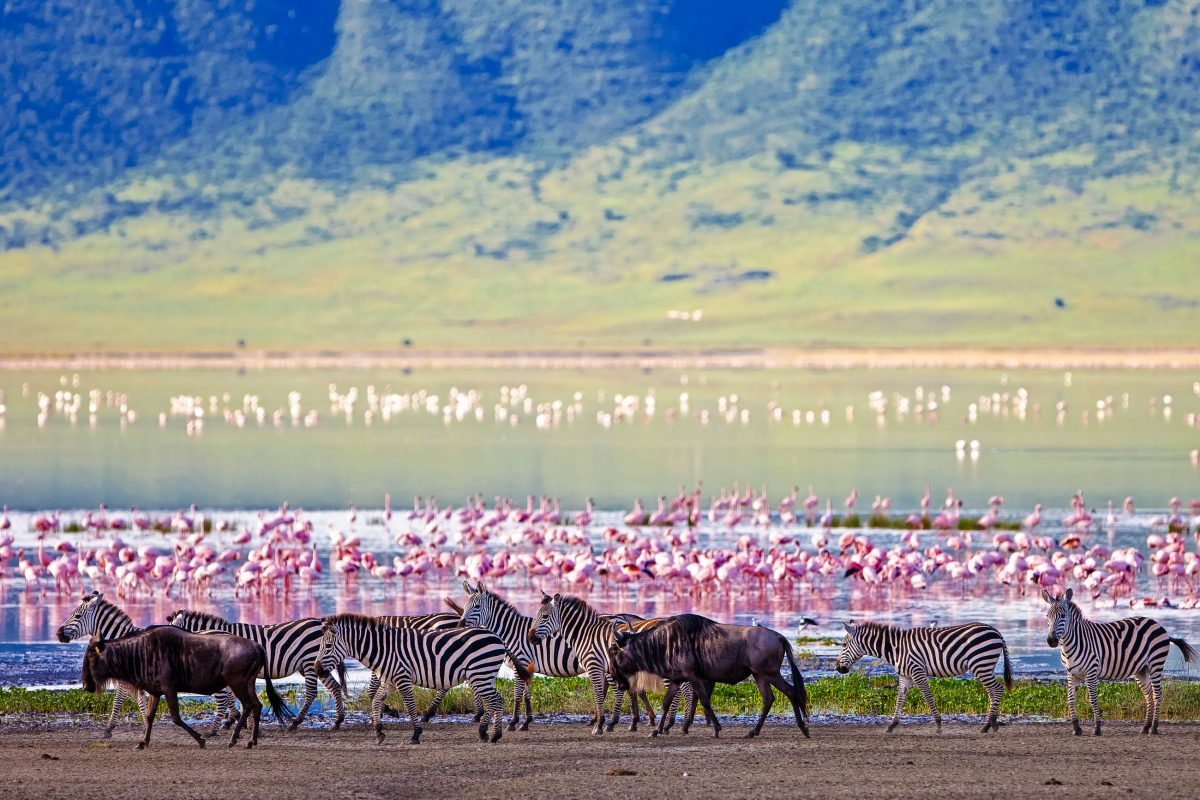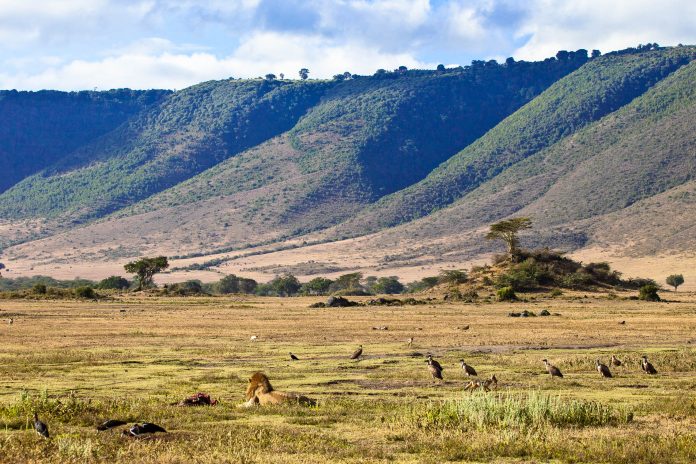Der Ngorongoro-Krater im Norden Tansanias ist die größte trockene Kaldera der Welt. Seine weitläufige Grassteppe beinhaltet mit 25.000 Exemplaren nahezu jede Wildtierart Ostafrikas.
Das Naturschutzgebiet Ngorongoro im Norden Tansanias liegt südöstlich vom berühmten Serengeti-Nationalpark knapp 200km von Arusha entfernt. Als einer unserer 10 schönsten Nationalparks von Tansania zählt Ngorongoro auch zu unseren Top 10 Sehenswürdigkeiten von Tansania. Das Wildreservat breitet sich um den riesigen Ngorongoro-Krater aus und gehört seit 1979 zum Weltnaturerbe der UNESCO.
Inhaltsverzeichnis
Entstehung des Ngorongoro-Naturschutzgebietes
Vor drei Millionen Jahren erhob sich im heutigen Ngorongoro-Naturschutzgebiet ein mächtiger Vulkan, der dem Kilimandscharo ebenbürtig war. Doch als der riesige Ostafrikanische Grabenbruch entstand, stürzte der Vulkan in sich zusammen und bildete den gewaltigen Ngorongoro-Krater mit einem Durchmesser von knapp 20km, die größte trockene Caldera der Welt. Innerhalb des Kraterkessels ernähren Grassteppen, Wälder, Moore und Schluchten etwa 25.000 Tieren, die nahezu jede Wildtierart Ostafrikas vertreten.
Das 8.300km² fassende Naturschutzgebiet Ngorongoro wurde im Jahr 1951 von den Briten gegründet, damals noch als Teil des Serengeti-Nationalparks. Nach andauernden Landnutzungskonflikten mit den Massai wurden die afrikanischen Ureinwohner von den Briten aus ihrem Land ausgewiesen.
Heute ist das Ngorongoro-Naturschutzgebiet wieder bewohnt und kann von den Massai in geringen Maßen als Weideland genutzt werden. Die Massai dürfen ihre Haustiere tagsüber grasen lassen, müssen den Krater jedoch am Abend wieder verlassen, um Platz für den nächtlichen Kampf auf Leben und Tod zu machen.
Das Gebiet um den Ngorongoro-Krater ist seit 3 Millionen Jahren von Menschen bewohnt, zurzeit leben dort die Massai, die die Datooga im frühen 19. Jahrhundert vertrieben haben. Einige imposante Feigenbäume, die den Massai und Datooga heilig sind, markieren noch heute das Grab eines Datoogo-Führers, der 1840 in der Schlacht mit den Massai ums Leben kam.
Als erster Europäer kam der österreichische Afrikaforscher Oscar Baumann 1892 ins heutige Ngorongoro-Naturschutzgebiet. Bis zum Ersten Weltkrieg wurde der Krater von zwei Brüdern aus Deutschland als Ackerland genutzt, die die wilden Tiere aus dem Krater trieben und gemeinsam mit deutschen Gästen immer wieder Treibjagden auf sie veranstalteten.
Beste Reisezeit für den Ngorongoro-Krater
Der Ngorongoro-Krater kann am besten von Juli bis November besichtigt werden. In diesen Monaten ist das Wetter am trockensten und die gigantischen Huftierherden sind unterwegs. Der Krater ist dann aber auch mit den meisten Safari-Autos bevölkert.
Auch während der Regenzeit ist nur Nachmittags und Abends mit einigen teils heftigen Güssen zu rechnen, ansonsten ist es ebenfalls trocken und die Luft reingewaschen. Die Stars des Ngorongoro-Kraters – die Wildtiere – sind das ganze Jahr über gut zu beobachten.
Ein Krater voller afrikanischer Wildtiere

Heute steht die weitläufige Grassteppe des Ngorongoro-Kraters unter strengem Schutz und so können die riesigen Herden auf ihrem Weg zu den besten Weidegründen und Wasserlöchern ungehindert passieren.
Während der Great Migration ziehen Millionen von Gnus und hunderttausende Zebras und Gazellen im Dezember nach Süden und im Juni in den Norden Tansanias bis in die Masai Mara in Kenia, immer den Regengüssen folgend. Ständige Begleiter der Huftierherden sind die Raubtiere, die ihrer Beute ebenfalls folgen. Somit lebt in der Ebene des Ngorongoro-Kraters eine der größten Raubtierpopulationen Afrikas.
Vor allem um den Ndutu Lake sind immer wieder Hyänen, Schakale, Leoparden, Servale, Geparde und Löwen zu beobachten, die Jagd auf Gnus, Antilopen und Gazellen machen. Rhinozerosse, Elefanten, Büffel und Nilpferde leben ebenfalls im Ngorongoro-Naturschutzgebiet. Afrikas „Big Five“ Nashorn, Löwe, Leopard, Elefant und Büffel sind hier somit alle anzutreffen. Zugvögel aus Europa und Asien sowie viele Affenarten machen ebenfalls hier Station, da im Ngorongoro-Krater so gut wie immer Wasser vorhanden ist.
Inmitten des Ngorongoro-Kraters befindet sich der Magadi-See, ein Salzsee, an dessen winzigen Krebsen sich tausende von Flamingos laben. Ähnlich wie beim noch stärker bevölkerten Natronsee in der Nähe hüllt das lachsfarbene Gefieder der Flamingos die Ufer des Sees aus der Ferne betrachtet in eine rosarote Wolke.
Olduvai-Schlucht – Die Wiege der Menschheit
Innerhalb des Ngorongoro-Naturschutzgebietes in den östlichen Ebenen der Serengeti liegt die berühmte Olduvai-Schlucht, ein Teil des Ostafrikanischen Grabenbruchs. Sie ist auch als „Wiege der Menschheit“ bekannt. Hier wurden die ältesten Funde der frühen Menschen getätigt. Der Homo habilis, das erste als Mensch bezeichnete Wesen, sowie andere Menschenähnliche wurden hier entdeckt, darunter ein 20.000 Jahre altes Skelett eines Homo sapiens. Die gut 40km lange Olduvai-Schlucht zählt zu den wichtigsten prähistorischen Stätten der Welt und gab bahnbrechende Auskünfte über die menschliche Evolution.
Safari im Ngorongoro-Krater
Innerhalb des Kraters bieten einige Lodges Unterkunft, in den Hotels am Kraterrand hat man eine atemberaubende Aussicht – dafür auch meist viele Touristen als Gesellschaft und die besten Plätze sind auch nicht billig.
Für einen kleineren Geldbeutel lohnt sich die Übernachtung in der Serena- oder Sopa-Lodge oder in einem Gästehaus in der nahegelegenen Ortschaft Karatu. Für eine Safari im Ngorongoro-Naturschutzgebiet sollte man sich zwei Nächte Zeit nehmen, danach empfiehlt sich eine Weiterreise in den weiter nördlich gelegenen Serengeti-Nationalpark.
Tipp: Obwohl man sich mitten in Afrika befindet, kann die Temperatur in der Nacht auf bis zu 0°C abfallen, also unbedingt auch warme Kleidung dabeihaben!
Weiterführende Links:





